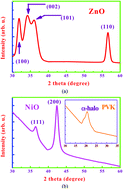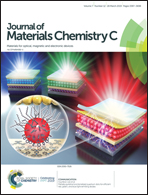High-performance organic/inorganic hybrid ultraviolet p-NiO/PVK/n-ZnO heterojunction photodiodes with a poly(N-vinylcarbazole) insertion layer
Abstract
In this study, an organic poly(N-vinylcarbazole) (PVK) layer was inserted between the p-NiO and n-ZnO inorganic layers and a p-NiO/PVK/n-ZnO organic/inorganic hybrid ultraviolet heterojunction photodiode (PD) was fabricated. The PD without the PVK insertion layer demonstrates poor rectifying behavior due to a large barrier existing at the p-NiO/n-ZnO interface. The p-NiO/n-ZnO interface has many defects, which causes a tunneling current, and thus linear current–voltage dependence. After inserting the PVK layer, the large barrier height at the p-NiO/n-ZnO interface was split into two small barriers; hence, the carriers can transport easily in the PD and possess superior rectifying characteristics. The visible-generated carriers created by the defects at the p-NiO/n-ZnO interface contribute to the visible response in the PD without PVK. However, the visible-generated carriers are trapped by PVK, reducing the visible response by approximately two orders. PVK has a strong absorption band between 320 and 350 nm, which greatly increases the UV response. Thus, the UV/visible rejection ratio enhances from 81 to 638, which is approximately 8 times that of the PD without PVK.



 Please wait while we load your content...
Please wait while we load your content...